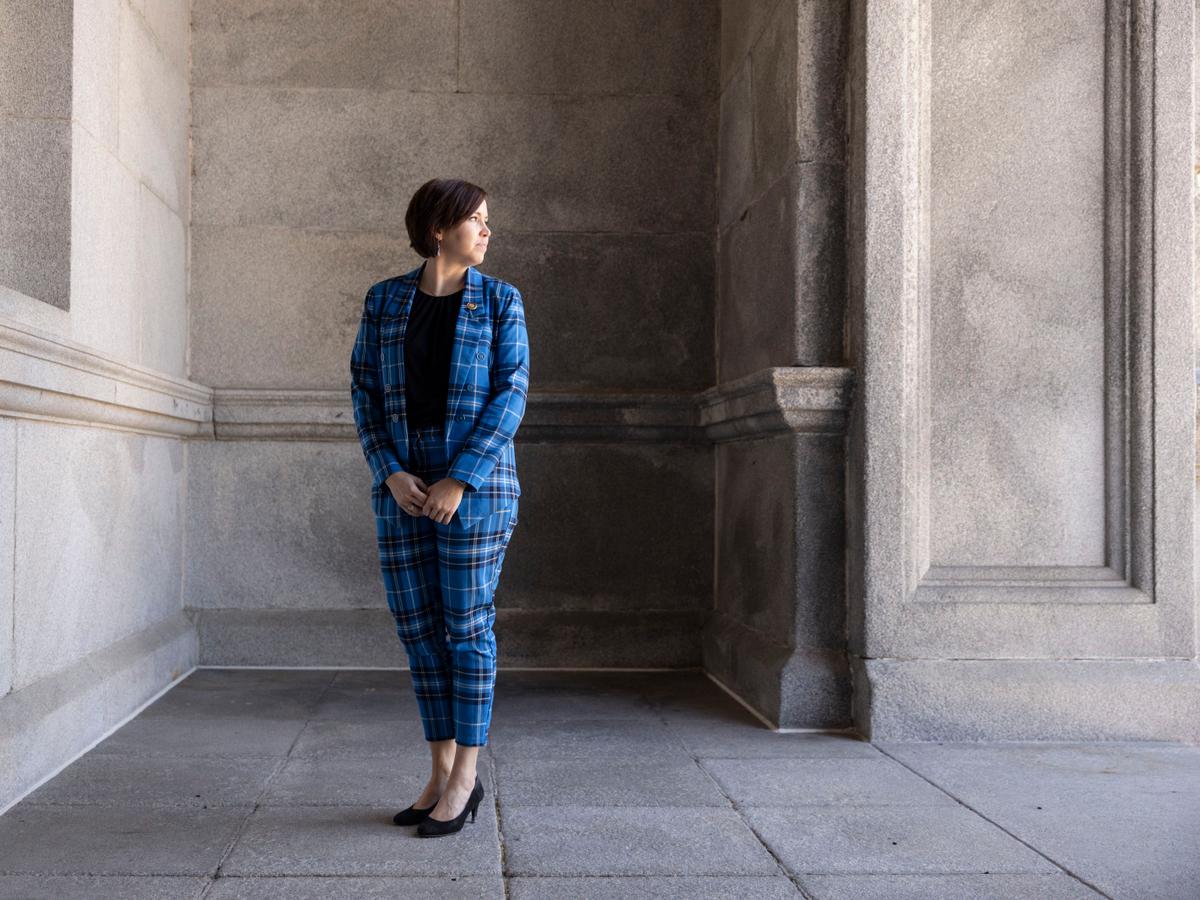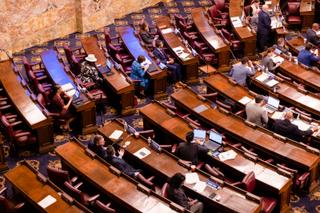How many women serve in the Pennsylvania Legislature? Spotlight PA

Spotlight PA Independent, nonpartisan newsroom operated by The Philadelphia Inquirer in partnership with PennLive/The Patriot-News, TribLIVE/Pittsburgh Tribune-Review, and WITF Public Media. Sign up for our free newsletter.
HARRISBURG — When Emily Kinkeed asked Lisa Bennington for advice on running for elected office, the former Pennsylvania legislator offered a blunt word of caution.
“Don’t run away, you are very smart. There are many other things you can do.”
A Democrat, Bennington won Allegheny County’s state legislature in 2006, but served only one term before retiring and returning to family law. She said her respect for the “paternalistic” culture of her legislature and its seniority prevented her from achieving her legislative priorities.
“I thought it was a very corrupt, very old boys’ club,” said Bennington. She failed to achieve goals like increasing access to emergency contraception for rape victims or extending the statute of limitations for victims of child abuse.
Kinkeed ran anyway and won a state seat in 2020, representing a portion of the Pittsburgh suburbs. Democrats said Bennington found a very different place when she got to Congress than the old boys’ club she had been through for more than a decade. Before.
“There has definitely been a shift in the number of women around and the types of men that are elected,” Kinquied said.
But the state legislature is still far from perfect for women, Kinkeed said, pointing to the recent resignation of State Rep. Mike Zabel (D.D.). Multiple people, including fellow lawmakersaccused him of sexual harassment.
“There is definitely something still in the works,” she said.
Amanda Berg / spotlight for PA
a century later first woman selected Both houses of Congress, including the Pennsylvania Legislature, are now headed by women. Republican President Pro Tempoa Kim Ward in the state Senate and Democratic Speaker Joanna McClinton in the state House of Representatives.
However, less than one-third of state legislators are women, 80 of the 253 members who serve in the state House and Senate.it puts the federation 27th place nationwide Proportion of women in parliament.
Eight women who are or used to be state legislators spoke to Spotlight PA about this article. Many women agreed that an increase in the number of state legislators would fundamentally change the policy debate, especially on issues such as education, child and elder care, and equal pay. .
“As people of color, and especially as women, the burden of having to educate our peers weighs heavily on us,” said Rep. ) said.
she said two-thirds of the people State minimum wage is female,Recent Legislative Efforts to Combat Hair Discrimination, which primarily affects black women. Brock, he said, felt he had to explain to some of his colleagues. [Pennsylvania] woman. “
“Women in Pennsylvania are our workers, the people who support our families and work for minimum wage,” Bullock said.
Fighting the “gatekeeper”
Women’s legislative power has grown steadily from Pennsylvania.
In 1975, only seven women served in the State Legislature and Senate. Since then, that number has increased slowly, but the biggest growth is seen in years, especially in 1992 for her and 2018 for her.
A wave of women ran and were elected to office in 1992, the year after the confirmation hearing of U.S. Supreme Court Justice Clarence Thomas, who was accused of sexual harassment. At the time, nine of her women were in the Pennsylvania Legislature.
The 2018 surge of nearly 20 women in the Pennsylvania legislature was the largest increase in women in the state legislature in 50 years. Two years after the election of former President Donald Trump sparked a wave of organizing for the Democratic Party, especially among women.
In conversations with Spotlight PA, lawmakers and academics agreed that the number of women in the Pennsylvania legislature remains at least partially half-hearted.
At the county level, party organizations typically identify potential candidates for elected office and express their support based on a variety of criteria, including perceived attractiveness and party loyalty. In low-participation elections, voters’ endorsements can go a long way when they choose among candidates with little visibility.
Debbie Walsh, director of the Center for American Women’s Politics at Rutgers University, said: “If there is no black woman, no Latino woman, no Asian woman elected, no hiring will happen and no money will flow.”
Walsh noted that Pennsylvania has “very strong political parties” compared to other states.
Of the eight current and former lawmakers who spoke to Spotlight PA for this article, only three were endorsed by the party when they first ran.
When state senator Lisa Boscola (D-Lehi) first ran for a seat in the state legislature in 1994, she ran without the endorsement of the county Democratic Party and gave herself the money to run the campaign. I had to lend it. Boscola said the leader of the Lehigh Valley party discouraged her from running because she felt “she wasn’t paying her dues.”
When she joined the state capitol, Boscola said she felt isolated at first, and a male colleague stroked her head and said, “The longer you don’t say, the longer you stay.” .
“If you’re a man and you go into the legislature, you’re right there with them. If you’re a woman, you have to start below that and earn it,” Boscola said. “We can see that women are having an easier time now. The numbers have grown so much that women are more accepted … they can’t ignore us anymore.”
Although the number of women overall has increased, the number of women of color in state legislatures has remained relatively flat.
Pennsylvania elects first woman of color president Congress in 1938, Japan’s first. Philadelphia civil rights activist and Democrat Crystal Bird Fawcett said at the time, First Black Woman Elected to Any Congress In this country, according to the Center for American Women and Politics.
But after Fawcett resigned a year later, women of color disappeared completely from Congress until 1984when Philadelphia Democrat Roxanne Jones Won a seat in the State Senate.
In the decades since, the number of women of color in Congress has slowly increased: in 1995 there were four. In 2005 she had six. There are currently no women of color in the state Senate. Meanwhile, women of color make up an all-time high of 12 in the state legislature, but still less than 5% of her total in the House.
Block believes the slow growth in these numbers shows that big political donors, not just party founders, have long been wary of betting on women of color. increase.
“The problem is that those who finance campaigns still tend to be predominantly men,” Bullock said. “If you can’t raise money, political parties and other institutions that support you will think you’re showing that you’re not a viable candidate.”
Rep. Tina Pickett (R., Bradford) agreed with Brock that when she first ran for office in 2000, she found female candidates harder to raise money than male candidates. But she thinks it’s gotten easier over time.
“When I first came in, it was very difficult for women to raise money,” she said. “In fundraisers, a check written to support a man’s campaign may double or triple her as a check written by someone to support a woman’s campaign.”
Shrinking Trust Gap
Last year’s election cycle involved Melissa Serato (D-Montgomery), one of the highest-paid campaigns in the Commonwealth. She was trying to flip the Republican seat that the Democrats needed to win in order to control the House.
After receiving approval from county officials, Serato received donations of hundreds of thousands of dollars from state Democrats, local party organizations, and special interest groups.
Serato said she hasn’t received special treatment because of her gender since arriving to work on the state capitol. pointed out that there is

Amanda Berg / spotlight for PA
Cerrato pointed out that the committee’s schedule changed at the last minute, so she had to figure out childcare options within hours. She said she is coordinating with other female members of Congress to organize childcare in the Capitol during budget hearings.
“That’s not something most men who have been in that position have had to face or deal with,” Serato said. ”
Kimberly Adams, a professor of political science at East Stroudsburg University in Pennsylvania, argues that in addition to structural party problems, historical lack of self-confidence may have hindered women’s candidacy. Some studies she points out confidence gap Women feel more qualified than men to run for public office.
“Women used to feel that they had to be perfect to run for public office,” Adams said, adding that the situation seemed to be changing.
“I don’t see it anymore,” she said.
Adams pointed to the rise of organizations seeking women’s candidacy. Her one such group is her Represent PA. This is a political action committee that donates to female candidates who want to protect access to abortion. last year, The group has spent over $700,000 A supporting candidate running for office in the state legislature.
State Senator Tracy Pennycuke (R, Burks) said she clearly noticed a confidence gap when she became a state legislator in 2021.
“It’s hard to find a mentor,” said Pennycuke. “But we are getting there.”
State Rep. Valerie Gaydos (Republican, Allegheny) noted that the true measure of women’s influence over state politics and policy goes beyond the tally of elected women. During her time at Harrisburg, she said the most significant change she saw was in the number of women serving on high profile staff, such as the commission’s executive board members and legislative chiefs of staff.
Gaydos was elected to the state House of Representatives in 2018, but first served in Congress in the early 90s as a staff member of the Senate Republican Caucus.
She described the change in “tone” upon returning to the legislature. The main reason is that we have seen more women involved at all levels of the legislature.
“The legislature reflects what we have seen across cultures: more women are in the workplace, they are more experienced … women [now] Please consider running as an option,” Gaydos said. “I don’t need to remove hurdles for us. I just want to find a way to jump over them.”
while you are here… If you learned anything from this story, pay upfront and become a member Spotlight PA someone else in the future spotlightpa.org/donateThe spotlight PA is foundation and readers like you A person committed to accountable journalism that delivers results.
https://www.spotlightpa.org/news/2023/03/pa-legislature-women-lawmakers-female-representation/ How many women serve in the Pennsylvania Legislature? Spotlight PA



